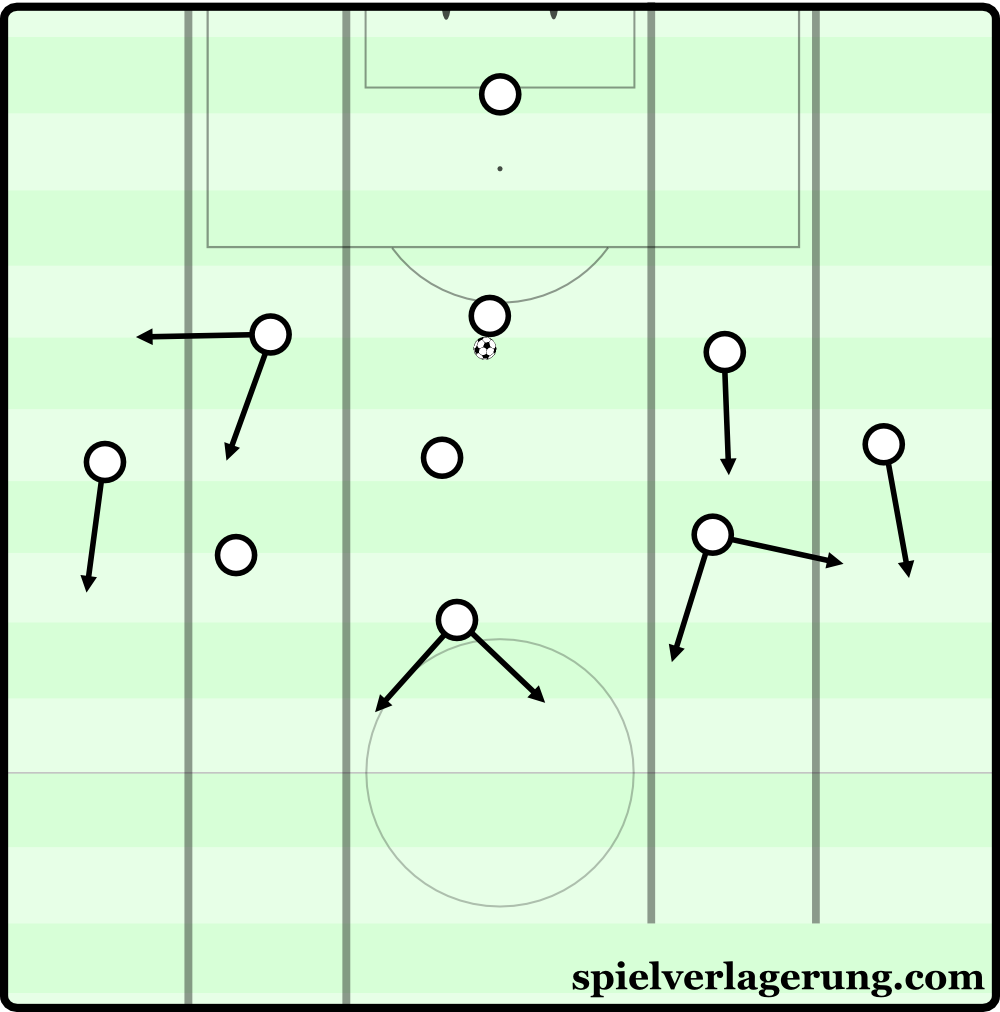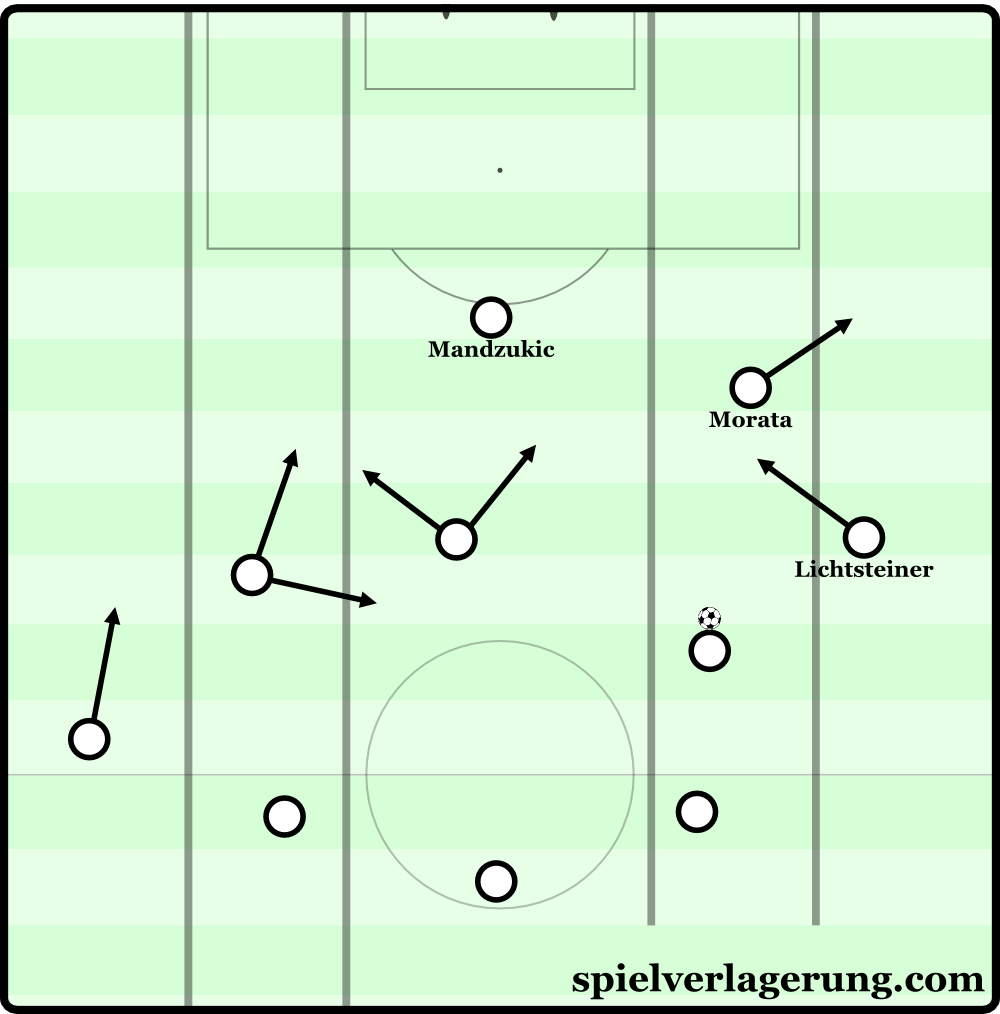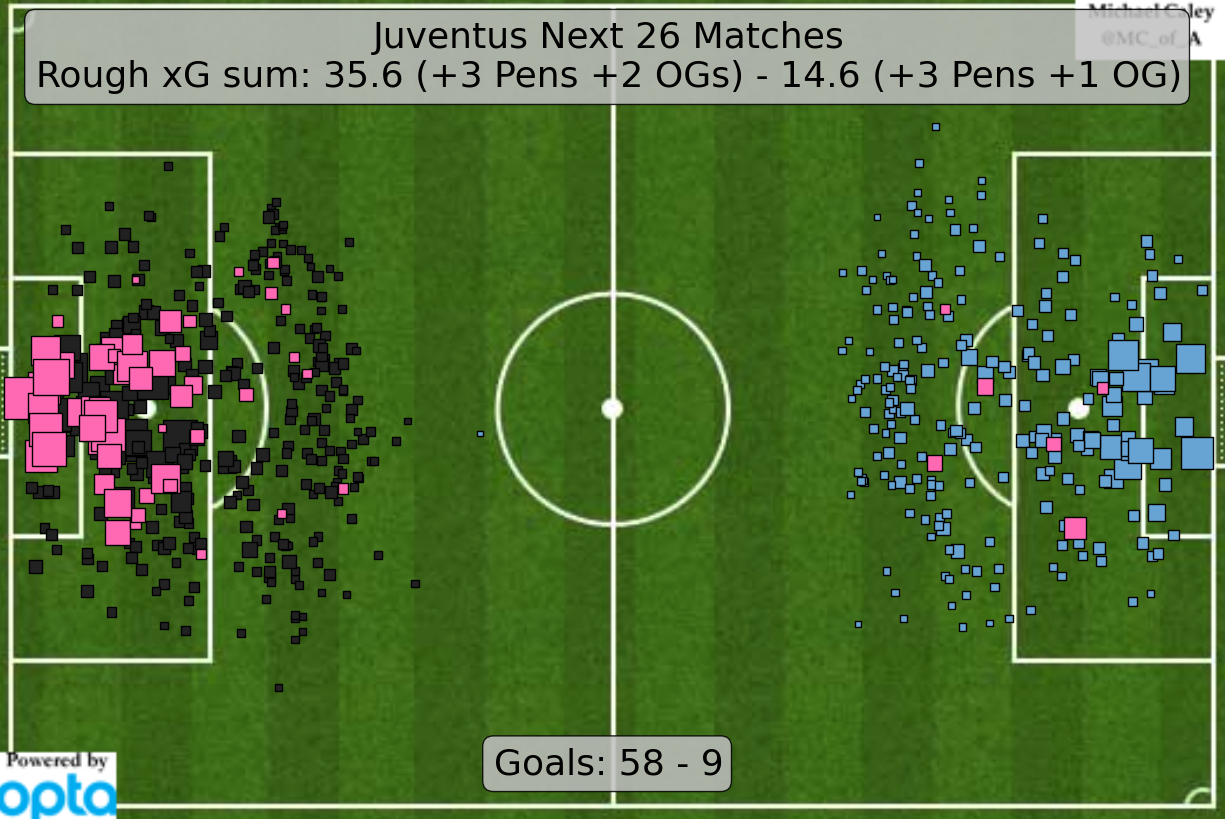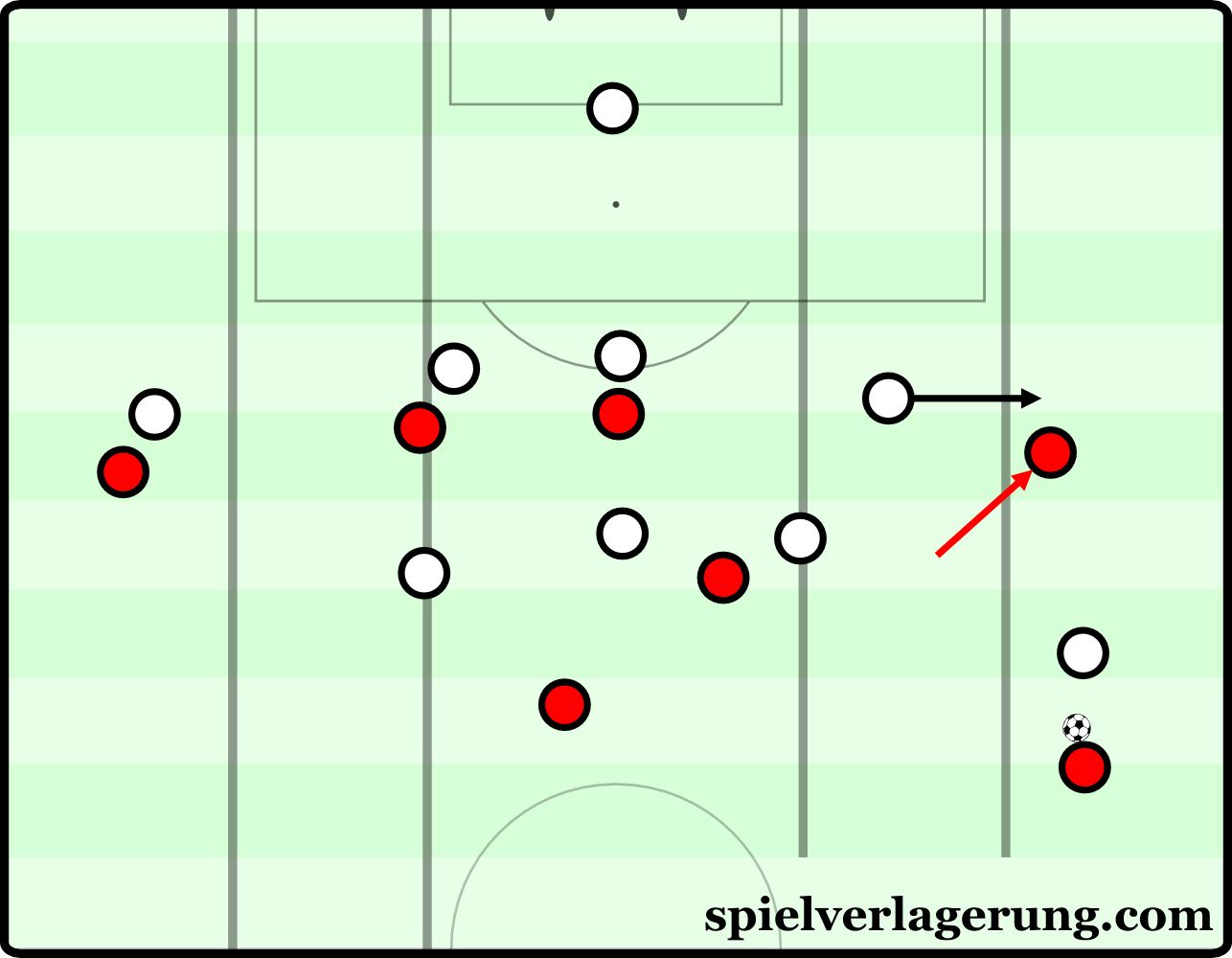Juventus’ controlled offense
Massimiliano Allegri’s appointment in 2014 was expected to signal the downfall of Juventus. Allegri, however, has silenced the critics quickly.
With one Serie A game remaining into the 2015-2016 season, Juventus have already secured the Serie A crown, their fifth consecutive Scudetto, after an outstanding season that started badly for the Old Lady, as she found herself in the second half of the table around October. Under Allegri, Juventus won the Scudetto once again, after piling a stretch of 25 wins out from the last 27 Serie A games.
Last season, Allegri’s side also reached an unexpected Champions League final in which they lost 1-3 to Barcelona after they have been able to tie the game 1-1. Not bad for a side unable to get its way out from the Group stage under the former management of Antonio Conte – currently Azzurri’s manager and next Chelsea gaffer.
This side, an improved Juventus side was kicked out from the top European clubs competition by Bayern’s Pep Guardiola, showing they are close to compete against Champions League giants. Allegri is proving to be capable of what Conte didn’t. Just how did Allegri exactly manage this turnaround? How did he bring Bianconeri back into continental prominence? Although Allegri hadn’t been rewarded as a strong tactician before he took the job at Juventus, he surely deserves a more respectful consideration now.
Emphasising their enhanced attacking game, this article will try to explain some of the tactical aspects behind Juventus’ rise from national leader into European contender.
Even if Gianluigi Buffon’s technical skills with the ball at his feet are far from perfection, Juventus usually put emphasis on passing their way out from deep in their own half even despite being pressed. The Azzurri No.1 is involved in the build-up to have him in addition to the central defenders as base for the progression of the ball. This is particularly helpful to stretch the opponents’ formation should they press high up the pitch. 3-5-2 has a natural La Salida Lavolpiana incorporated and Juventus’ centre-backs exploit it.
The Salida Lavolpiana, sometimes referenced as Lavolpista, is a concept used in football to refer to the start of the offensive phase in which the central defenders fan out wide and a central midfielder drops in between. In a 3-5-2 system, the central player between wide positioned centre-backs is already there. And in case, he gets pressured he can always pass the ball back to the goalkeeper, who then has enough time to at least knock the ball forward.
Leonardo Bonucci, Andrea Barzagli and Giorgio Chiellini are all smart and experienced players, able to manipulate the opponents’ shape and open the passing lanes to the interiors and the wing-backs. They do it by moving the ball from the right half-space to the middle to the left half-space, until a free man is available.
If the opponent decides to press high up, Bonucci is particularly able to prevent turnovers by quickly playing accurate passes to either Stephan Lichtsteiner or whoever is the left-winger or to the forwards. In order to create strong connections and minimise the possibility of losing ball possession, both Claudio Marchisio and Paul Pogba usually move back to link the play between defence and midfield.
When Allegri stepped up following Antonio Conte’s departure in 2014, he immediately talked about improving Juventus possession and positional game, arguing his team has to be able to understand when they can furiously attack – as they did under the previous regime – and when they have to slowly circulate the ball to manipulate opponents. In contrast to Conte’s system, Juventus now put more emphasis on possession and circulation in the middle of the park.
In Juventus’ build-up, midfielders are focused on positioning, and their contribution to ball circulation is more consistent. The wider centre-backs regularly operate in their respective half spaces, with both Marchisio and Pogba offering them a passing option and therefore connection to other areas of the field. The playmaking abilities of Juventus’ deeper players are outstanding and important for said philosophy of calmly moving the ball across the field and avoiding pointless long balls.
Against passively defending opponents, both Chiellini and Barzagli are ready to push with the ball through their respective half-spaces. In doing so, they often drag out opponent’s midfielders to open up passing lanes towards Pogba, Marchisio or Paulo Dybala who roams around in the higher zones of the pitch. This kind of build-up play allows Juventus to be ready to progress the ball, with a good structure covering the field from wing to wing, creating interesting passing angles.
Juventus’ offensive strategy
Juventus are a possession-based side. They exploit the intriguing central presence a 3-5-2 attacking shape gives, and they are very central-space-orientated. A key factor of Juventus’ ball possession strategy is the presence and the role of Bonucci in their system.
Bonucci shows excellent positional intelligence in his sweeper role from which he supports the Bianconeri’s structured offensive play through his long and short penetrative passes. He also recorded a 87% average passing accuracy – one of the highest among the Serie A centre-backs with at least 30 games played. That said, he’s also a strong defensive machine as he has made 82 interceptions, 155 clearances and 13 blocks.
With the centre-backs so pivotal to Juventus in offense, Allegri recently started to experiment left-back Patrice Evra as centre-back. The utilisation of Evra in the build-up is very important in moving the ball towards forward areas. Evra’s role is particularly interesting from a tactical perspective. The French full-back can add a different orientation compared to the other centre-backs, as he can move the ball through the left half-space but also situationally through the outside lane when capitalising on his abilities as a winger.
Another potential aim of Evra’s utilisation as centre-back is that, progressing the ball forward, he can drag opponents out of position, opening room for the midfielders to receive the ball. The three centre-backs, Marchisio, Pogba and the third midfielder, usually Sami Khedira, often remain between the half-spaces and the middle of the pitch. Although, at the start of this season, they paid a price to Andrea Pirlo’s departure, the midfield has been much more consistent with Marchisio, Pogba, and Khedira.
An interesting part of Juventus’ midfield game is their asymmetrical shape, as Khedira often drops in the right half-space to support Marchisio in build-up. Playing to Marchisio’s right, Khedira acts at the level we saw him playing for Real Madrid. He’s currently one of the best central midfielders in Europe. When he drops back, Pogba takes a higher position. With Pogba inclined to drive forward, Khedira’s movement balances the team’s structure.
Under Allegri, the same Pogba has shown his versatility by dropping deep towards the centre backs in the build-up or floating through the left half-space to receive the ball with the team in possession of the ball. Pogba often does contribute to their build-up by dropping deep alongside Marchisio and by creating a passing lane between him and the centre-backs in the way to receive the ball when Marchisio is covered by the opponents. His level of play strongly increased under Allegri’s tutelage. Pogba became a more complete player, adding playmaking abilities to his resume. He scored seven goals this season, creating 50 chances and 12 assists.
Marchisio, once a classic box-to-box midfielder, is now playing at the base of the midfield. He uses his strong positional awareness to support the team’s structure by positioning himself to offering the centre-backs a passing option if he isn’t covered closely. Marchisio lowered his offensive stats, but he’s still an offensive weapon as he created 22 chances and recorded two assists. However, due to his well-rounded skill-set he also conducts the midfield in defence.
Due to Bonucci’s pivotal role to Juventus’ build-up, one could think opposing forwards naturally pay a lot of attention to him. However, that’s not always the case, because opponents usually opt to stay deep and compact, leaving Juventus’ centre-back free to orchestrate the build-up. You have seen something different in the clash between Juventus and Milan, Sinisa Mihajlovic’s last game in charge of Rossoneri, when Milan played a man-orientated pressing scheme to effectively stop Juventus’ deep build-up through a tight man-marking of both Bonucci and Marchisio.
That said, Juventus’ possession game is strongly focused on diagonal or vertical passes. Their main goal is to play to the feet of their centre-forwards, but they could also play to their wing-backs to then link up with the forwards.
Their wing-backs, normally bypassed in build-up, usually stay high up the pitch, providing depth and width. In detail, Lichtsteiner usually puts himself a bit higher up the field than the left-wing-back, Alex Sandro or Patrice Evra as the Swiss wing-back relies on his pace to drive into the shooting area or to provide crosses into the penalty box, while the left-wing-back normally looks for shorter passes. Especially Evra plays a more defensive-orientated role when he’s fielded as wing-back. Allegri can also count on Juan Cuadrado. Above all, he successfully made a transition from offensive winger into an effective wing-back. In fact, it is not uncommon to see Cuadrado defending in deeper areas, acting as a more orthodox wing-back in a 5-3-2 formation.
The fact that Juventus are centrally orientated when in possession, means they are able to counterpress effectively after losing the ball, although Juventus don’t focus on counterpressing as a main defensive weapon, as they often try to get back into their defensive shape to then keep the opponents off the own penalty area.
Another interesting feature of Juventus’ offensive strategy is the position of the forwards, Dybala in particular. In fact, the Argentinian forward is usually positioned as a No. 10, playing just behind his colleague upfront. It means Juventus often attack in a structured 3-5-1-1 formation. When Pogba moves himself higher up the pitch, with Dybala dropping back, this creates a 3-4-2-1/3-1-4-1 pattern, with Dybala and Pogba working in the same horizontal channel with the wing-backs behind the centre-forward.
Dybala is important to Juve’s system in the final third of the pitch where he’s particularly able to link with his teammates. Things are a bit different when Allegri fields Alvaro Morata alongside Mario Mandzukic. In this case, the Spanish forward usually floats around the final third of the pitch, acting like a true second forward by drifting from half-space to half-space.
With Morata moving wide right, it isn’t unusual to see Lichtsteiner rushing to the inside to play a one-two or other various combinations in order to break through opponent’s defence. Also, pairing Morata up top alongside Mandzukic gives Juventus a good chance to play high and long passes to overcome opponent’s pressure, while utilising their forwards’ strength in aerial duels
Expected goals is a strong indicator of a team’s performances. Here are two diagrams showing the xG difference between Juventus’ first 10 matches and the next 26. They are a pretty great example of an xG fluke who turned their season around as expected from good play / bad finishing in the early months. I can’t thank Michael Caley enough to provide us this model.
Allegri’s 4-4-2/4-3-1-2
As it happened in the first Champions League leg against Bayern’s Guardiola, it is not so infrequent to see Allegri organise his side in a 4-4-2 or in a 4-3-1-2 formation. Playing with two blocks of four, the two forwards generally have to cover any early passes across the middle, while Pogba retains a position as left midfielder. On the right side, Lichtsteiner acts as a conventional winger, with Barzagli behind him. That being said, this 4-4-2 is still a very fluid shape as one of the main movement includes Pogba floating through the middle in the first and second build-up phase with the left-back pushing forward. So Juventus rotate into something resembling their usual 3-5-2.
Allegri also flirted with the 4-3-1-2 – maybe his favourite formation. But Juventus showed some troubles with this shape, as their midfield diamond looked unstable in defence. An issue for Allegri’s 4-3-1-2 shape is the strong man-oriented zonal marking system he likes (see below in this article). Although this system generally offers good compactness and defensive support in the middle, it often left Juventus’ backline exposed due to the issues with the interior midfielders, as they weren’t always able to slide wide to the flanks quick enough, with the opponents ready to capitalise from the theoretical advantage on the wings against a classic 4-3-1-2 narrow formation.
As if that’s not enough, Juventus lacks a No. 10, an attacking midfielder who can fill in the role behind the two centre-forwards. That is the reason the Bianconeri flirted with Julian Draxler and Henrikh Mkhitaryan last summer. Although Dybala often acted as a trequartista, he’s not the kind of No. 10 Allegri likes. The Juventus manager wants a No. 10 able to collapse deep to help the other midfielders. It leaves Roberto Pereyra as the only player able to play this role according to Allegri’s concept. Pereyra’s movement is vital to stabilise the team’s defence, but he’s far from being Dybala, Draxler and Mkhitaryan in terms of his ability to create chances.
This is one of the main reasons behind Allegri’s decision – after some poor performances – to return to the 3-5-2 formation which had brought Juventus much success under Conte.
Positional Play
Although it is hard to affirm that Juventus practice a total and aware positional play, some concepts of positional play are there. First and foremost, Juventus show a clear will to manipulate their opponents shape when in possession. Although they don’t appear focused on playing to the strong side to move the ball to the weak side afterwards, they are ready to switch sides depending on the phase of the play. Their deep build-up play also reminds us of some aspects of Juego de Posicion as Juventus move the ball with the aim to stretch and manipulate the opposing team’s compactness and find the free man between their lines. When opponents press higher up the pitch, Juventus use backwards and sideways passes – involving Buffon too – in the way to stretch opponents’ defensive shape to exploit the space they have created between their defensive lines.
One of the key influences in Juventus’ improvement in terms of positional play under Allegri is his implementation of a bigger focus on ball possession. It is no secret that Allegri likes a more controlled style of play than former coach Conte. Bianconeri’s shape has recently much improved under Allegri’s tutelage. Now Juventus have more of the ball, through a more structured approach. They have an average of 54.3% ball possession per game with 85% passing accuracy. Allegri stressed this point by introducing a clear new guideline in the team’s game plan as Juventus have been able to adapt and understand when they have to play quickly and when they have to simply circulate the ball.
Juventus’ defence
To finish this article, a few words on the defensive aspects. When the opponents have the ball, Juventus aren’t afraid to stay deep in their own half, putting all eleven men behind the ball. Allegri has installed a man-oriented zonal marking system, which means a particular is asked to man-mark the opposing player that enters his zone. A man-marking variation at first, this system is useful to create a reactive strategy as the positioning is determined by the opponents’ movement and not just by the position of the ball.
When well-executed, a man-oriented zonal marking system allows a team to maintain control of the opponents in the area where the ball is. On the other hand, this system shows a lack of compactness with team-mates often too far away to protect each other. Thus, sometimes it causes some instability due to the lack of support by teammates.
In particular, the centre-backs are strongly oriented on forwards as they often break the line (Italian term: rompere la linea. It means a defender leaves the backline to move high up to cover an opponent) to follow them.
That said, this system still allows Juventus to often regain possession through tackles and the centre-backs’ individual man-marking skills. Another key point of Juventus’ defence is their fluid structure. Within their system, Juventus move out from their base 3-5-2/5-3-2 into a situational 4-4-2 shape as Lichtsteiner step up to join the three central midfielders in the second line of defence. When this is the case, Barzagli moves towards the touchline, providing stability as a right-back. On the other side, the left wing-back usually moves down and plays deeper when the ball is on the right flank.
When the ball is on the left side, the left central midfielder has to cover the flank, although Pogba isn’t so comfortable in defending wide areas. Fort instance, that was the main reason that led Allegri to put the French midfielder into the right half-space against Milan, introducing Kwadwo Asamoah to cover the flank against Sinisa Mihajlovic’s wing-orientated 4-4-2 system.
Mandzukic and Dybala are key components of Juventus’ defensive game plan as well, as both stay near the ball to cover passing lanes or press against the opponents’ build-up. Their defensive work is pivotal as their positioning creates a high level of vertical compactness.
Juventus also showed an interesting tactical weapon by using waves of pressing. It means they usually start their game deploying an aggressive yet disciplined pressing in the way to disorganise opponent’s initial build-up. Allegri utilised this final-third-press against Bayern in the second leg of this year’s Champions League game between Juventus and the Bundesliga giant. Operating with a semi-man-orientated pressing system, Juventus took control of the central areas of the field forbidding Bayern from making progress via Xabi Alonso, Arturo Vidal and Thomas Müller. They utilised Morata, Pogba and Khedira to prevent Bayern from making vertical passes or runs through the middle. As expected, Juventus didn’t press high up the pitch throughout the entire game, as it is also usual for them. In the same game, Allegri showed to be a more wary tactician than some people think by copying Borussia Dortmund’s defensive approach against Bavarians.
After Borussia showed the effectiveness of a back five versus Bayern, Allegri repeated this strategy deploying a 5-4-1 formation in the later stages of their pressing. So, when Bayern had possession in Juventus’ half, Allegri utilised his lateral centre-backs to cover the half-spaces, notably using Evra to pick Müller. Evra tracked Müller very well restricting his movements. Although they were eliminated, Juventus partly shocked Pep Guardiola by playing an accurate defensive game plan. Allegri was brilliant to expose Bayern’s weaknesses during this match.
Conclusion
With 25 victories out of their last 27 Serie A games, Allegri orchestrated a resurrection after an awful start of the season that left Bianconeri 11 points behind the then-leader Roma at the end of October. Juventus faced a rough start due to the losses they had in last summer’s transfer window when they saw Pirlo, Carlos Tevez and Vidal leaving the team.
A lot of credit has to be given to Allegri. With patience and hard work, the Italian manager reversed the course of the season. He did it staying faithful to his tactical principles.
Michele Tossani regularly writes for Futbol Tactico and MartiPerarnau.com. Follow him on Twitter @MicheleTossani







Keine Kommentare vorhanden Alle anzeigen